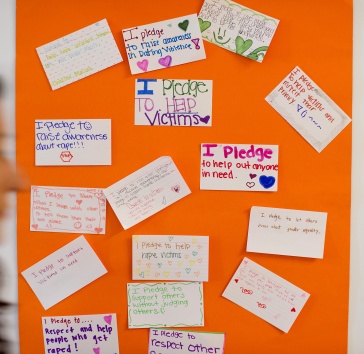Re-framing our Frameworks

I love frameworks. Ask any of my colleagues at the Foundation and they’ll tell you that I’m the first to want to map an issue – using systems mapping, driver diagrams, 5 why’s – if it can help make sense of the complex, I’ll use it. So, naturally, I was assigned to lead our Collaborating for Healthy Communities initiative.
I set out with gusto to uncover and understand the frameworks that lead to successful multisector collaborations and the models that make them successful. Then, I had to pause.
In my seemingly endless search for lessons, guidelines, and specific answers about what works, I stopped and realized that the thing that makes collaborations tick is not hidden in a model and often isn’t even written down. It’s the intangible; it’s something deeply tied to the history of a community and a culture; it’s the lived experience of those impacted by violence and poor health – many of whom may never have spoken a word about how it affects them or how the systems that serve them could do better because that’s just life as-is. The effort to change them seems futile and the power to do so feels very far away.
I found that the answer to transformation-through-collaboration is not a formula or framework at all. It’s the relationships between those who can pinpoint community issues, those who can articulate solutions, those who see and live the same threats and challenges of those we aim to help, and those who have the resources to do something about it.
Over the past several months, I sat in many rooms – large and small – focused on discussing learning and opportunities to advance multisector collaboration, and it’s clear that we’ve frameworked the heck out of this thing. Collaboration is not a new idea, though today, we have more sophisticated names for each model, the most popular of which is Collective Impact. These models are important because they identify a consistent set of elements that are foundational to facilitate cross-sector partnerships, such as having a shared agenda and agreed upon outcomes – both of which are critical to making sure that collaboratives are not only working toward the same goal, but that they have equal accountability to achieve that goal. Executing an approach that is mutually reinforcing for all parties involved is also essential to “moving the needle” on any issue or set of issues. Success also requires a strong “engine” or backbone with sufficient resources and guidance needed to keep the collaborative moving forward.
The challenge is, despite how logical these models and frameworks may appear on paper, they can still fail - and fail quickly. If any of these elements isn’t there or doesn’t fit perfectly into place, what should work doesn’t.
In our zeal for depicting the “how” of collaboration, we’ve lost some connection to the “who” and the “why.” Organizations like the Tamarack Institute have started the conversation to bring us back to the “who” and the “why” by proposing revisions to the Collective Impact model that center it around equity and community, as outlined in their recent publication Collective Impact 3.0. It’s a great start to reorienting this work around those whom its meant to benefit and grounding it in the elimination of prevailing disparities.
What I’ve learned through this process is that, ultimately, it’s the relationships among multiple people, families, and leaders in communities – many of whom have historically not always been heard or recognized – that can make or break any collaborative before it even begins.
In our most recent docket of grants, we’re hoping to value and lift up this critical ingredient. The people who are involved in, and affected by, multisector collaboration must be a part of the conversation early and included in its design. Through a partnership with the Public Health Institute, we plan to offer training and support for local residents, organizations, and systems to engage in more inclusive dialogue so that when and if collaboration is deemed a promising solution to an end, the voices of those most impacted are at the table. We’re also partnering with the Nonprofit Finance Fund to help community-based organizations that are already prepared to engage in collaborations around health or preventing domestic violence to ensure that they have what they need to make progress.
We’re beginning to see what it can look like when collaborations start with community. During a recent visit to Stockton, California - one of six CACHI Catalyst sites - these living examples of the unwritten elements for success were everywhere. Was there a strong backbone organization? Yes. Were there shared outcomes across the leaders, organizations, and systems involved in the collaborative? Yes. Were there mutually reinforcing efforts? Yes. But what made this collaborative work, and work so well, was harder to pinpoint. As the day went on, I realized that the fundamental key was relationships. The growing connections among people who have made a collective commitment to generate change in their community - whether as a resident, an elected official, an advocate, a service provider, or a community leader. One leader I spoke with actually added another critical element to their equation for success: hope.
Models and frameworks serve a purpose, and they can be a good place to start, but the magic ingredient to effective collaborations will always be the people behind them.
To learn more about available grants for community collaboration, visit us here. And to stay in the loop on what we’re continuing to think about, learn, and fund, sign up for our email list.
Together, we can move California further forward.
Get our newsletter
Sign up for occasional event announcements and our newsletter, Intersections, to learn more about the work we’re supporting to make California the healthiest state and end domestic violence.
